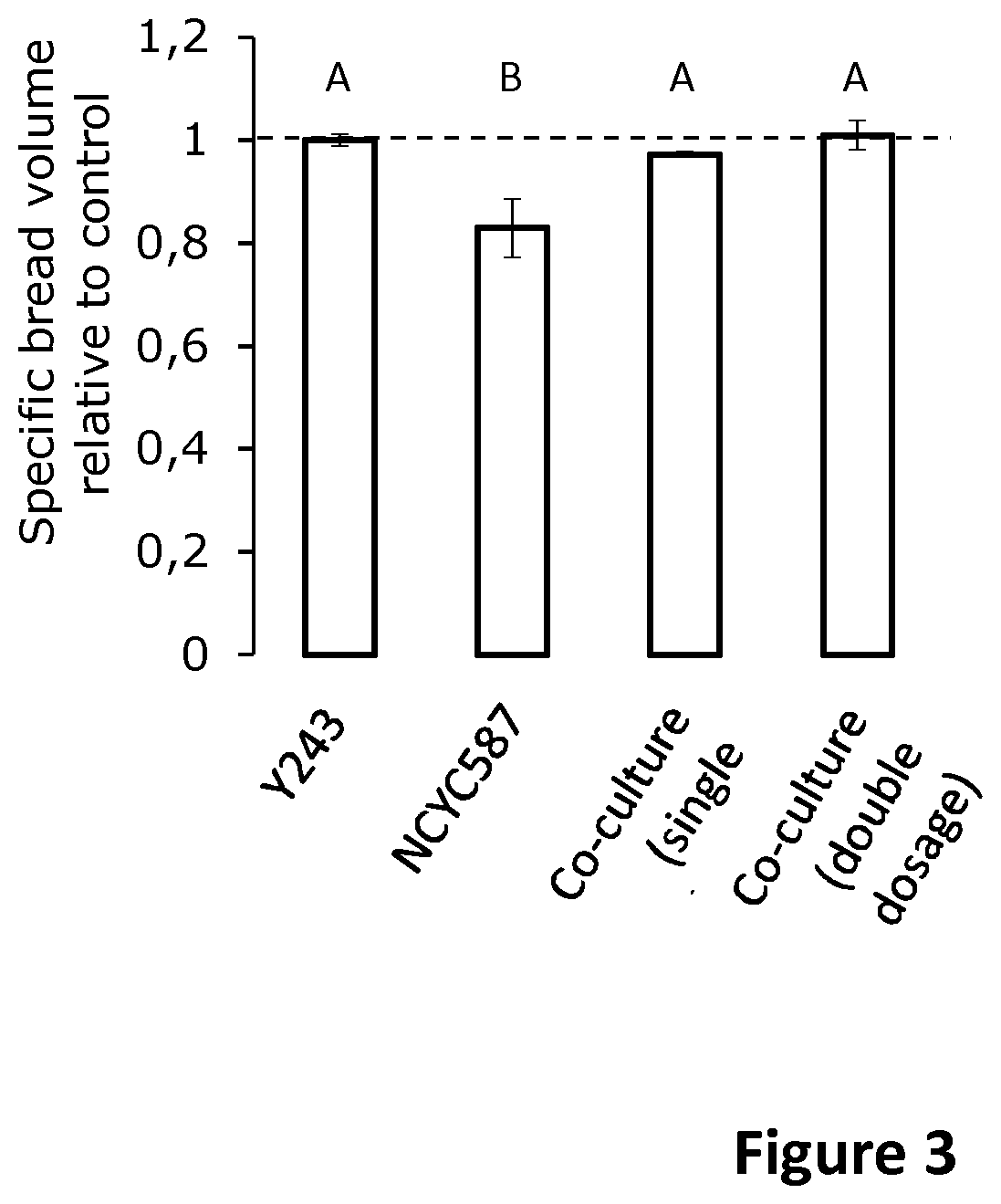Wholemeal bread with reduced fodmap content
- Summary
- Abstract
- Description
- Claims
- Application Information
AI Technical Summary
Benefits of technology
Problems solved by technology
Method used
Image
Examples
example 1
and Methods
Materials.
[0158]Wheat variety Terroir was obtained from the experimental site of the Université de Liege (Agro-bio Tech, Gembloux, Belgium). Terroir wheat was milled into flour with a Buhler MLU-202 laboratory mill, with a milling yield of 69.3%. The bran and shorts fractions were further reduced in size (<500 μm) with a Cyclotec 1093 sample mill (FOSS, Höganäs, Sweden), after which they were added to the flour fraction in their original proportions to produce wholemeal. Terroir wholemeal was finally enriched with 5% vital wheat gluten with a protein content of 82.4% (w / w) (Tereos Syral, Aalst).
[0159]A fructanase mixture (E-FRMXLQ) containing exo-inulinase (2000 U / mL on kestose at 40° C.) and endo-inulinase (100 U / mL on fructan at 40° C.) was obtained from Megazyme (Bray, Ireland). Invertase (I4504) from S. cerevisiae (≥300 U / mg solid on sucrose at 55° C.) was obtained from Sigma-Aldrich (Bornem, Belgium). A commercial S. cerevisiae bakery strain (Y243) and three differen...
example 2
of FODMAP Levels in Dough and Bread Samples Fermented with Different Yeast Cultures
[0170]Fructan degradation was evaluated during bread making The different yeast cultures that were used as leavening agents, represented in Table 1, include S. cerevisiae and K. marxianus monocultures, but also co-cultures of both species.
TABLE 1The composition of the different yeast cultures that were usedYeast dosageYeast dosage(g yeast(g yeast drypellet / 100 gmatter / 100 gYeastYeastwholemealwholemealcultureStrain codeCompositionflour)flour)MonocultureY243S. cerevisiae5.30%1.06%Y243Y243MonocultureNCYC587K. marxianus5.30%1.06%NCYC587NCYC587Co-cultureY243S. cerevisiae2.65%0.53%(singleNCYC587Y2432.65%0.53%dosage)K. marxianusNCYC587Co-cultureY243S. cerevisiae5.30%1.06%(doubleNCYC587Y2435.30%1.06%dosage)K. marxianusNCYC587
[0171]FIG. 1A shows fructan levels in dough and bread samples measured after mixing (4.5 min), after the first punch (56.5 min), after proofing (130.5 min) and after baking (143.5 min). S...
example 4
ume of Breads Prepared with Different Yeast Cultures
[0182]The volume of breads prepared with NCYC587 and the co-cultures were compared with the volume of bread prepared with the commercially used S. cerevisiae strain Y243 (FIG. 3). The volume of breads prepared with Y243 and the co-cultures was not significantly different. Indeed, the production of CO2 by these cultures during proofing (90-126 min) was comparable and sufficient for optimal loaf volume. Breads prepared with the NCYC587 mono-culture, had a significantly lower volume than breads prepared with Y243.
Example 5—Fructan Degrading Capacity of Different K. marxianus Strains
[0183]K. marxianus strain NCYC587 degraded the wheat grain fructans present in Terroir wholemeal almost completely (>90%) during fermentation. To see if this also is the case for other strains, two other K. marxianus strains were tested. First, the CO2 production rate of the two strains (MUCL29917 and MUCL53775) was tested in Terroir wholemeal dough (FIG. 4...
PUM
 Login to View More
Login to View More Abstract
Description
Claims
Application Information
 Login to View More
Login to View More - R&D
- Intellectual Property
- Life Sciences
- Materials
- Tech Scout
- Unparalleled Data Quality
- Higher Quality Content
- 60% Fewer Hallucinations
Browse by: Latest US Patents, China's latest patents, Technical Efficacy Thesaurus, Application Domain, Technology Topic, Popular Technical Reports.
© 2025 PatSnap. All rights reserved.Legal|Privacy policy|Modern Slavery Act Transparency Statement|Sitemap|About US| Contact US: help@patsnap.com



